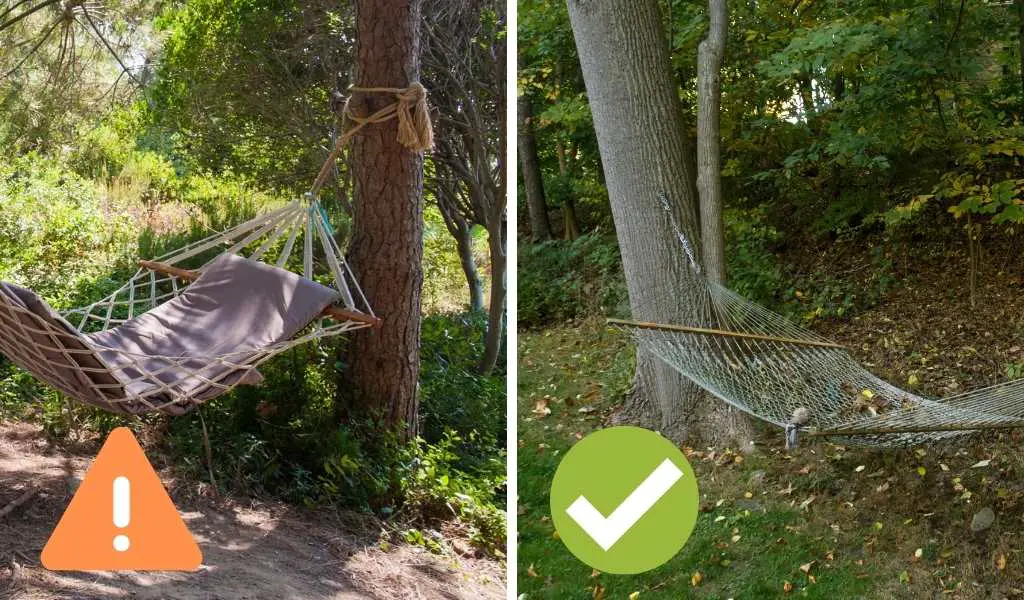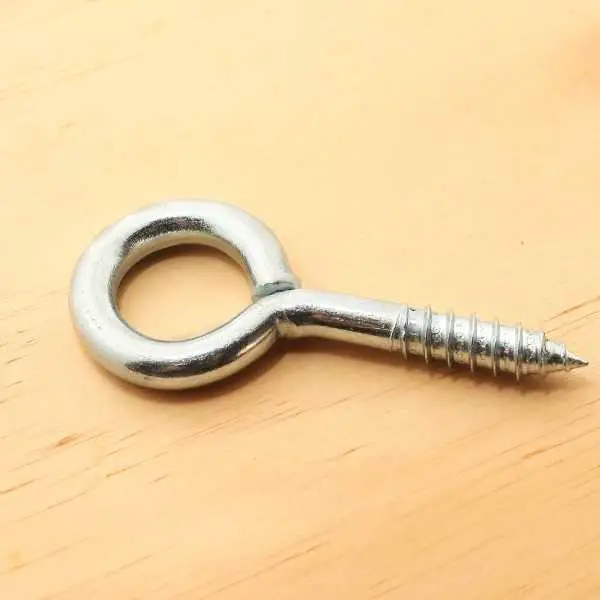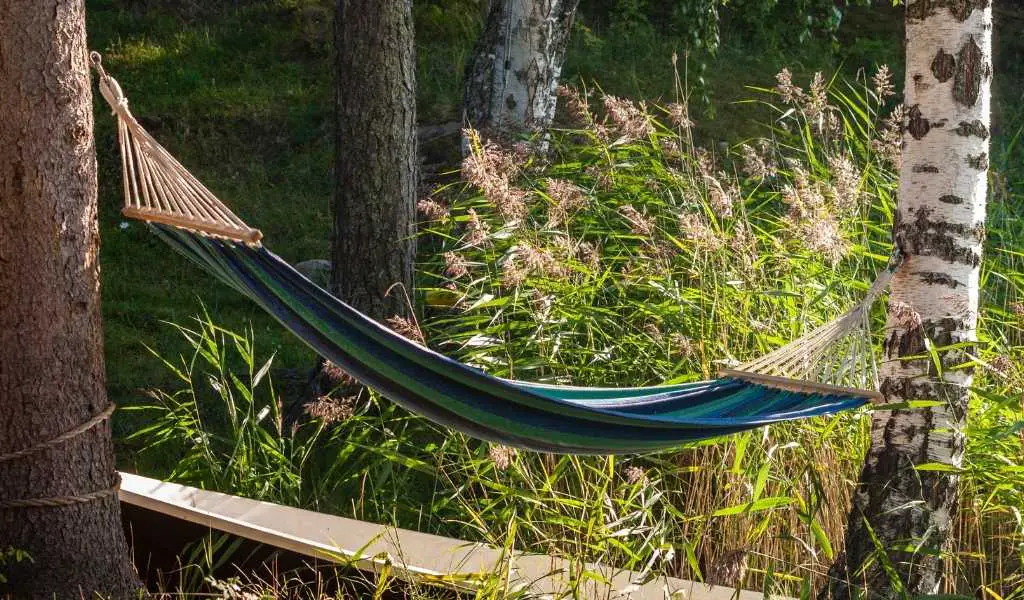Disclaimer: As an affiliate I may earn a commission on any qualifying purchases, including those from Amazon.com, at no extra cost to you – read more.
At first glance, a hammock seems like a very eco-friendly way to enjoy nature. But this is only the case if the hammock is hung correctly.
A poorly hung hammock can kill a tree over time as the ropes will eat away at the bark which is the trees protective barrier from insects and disease.
If you’re camping temporarily, then you don’t have much to worry about and can continue to use rope or straps. However, for more permanent fixtures, it’s recommended to use screws or eyelets as these will do the least damage in the long term.
- Will a Hammock Kill a Tree?
- How Do You Hang a Hammock Without Damaging a Tree?
- Will Putting a Nail in a Tree Harm It?
- What About Hammock Camping?
- How Do Hammock Tree Straps Work?
- What Are the Best Hammock Straps?
- How Thick Does a Tree Need To Be For a Hammock?
- Tips for Safely Hanging your Hammock from Trees
Will a Hammock Kill a Tree?
Surprisingly, it’s the use of a hammock rope that can do the most damage to a tree, rather than any permanent hooks or screws.
If the rope is tied very tightly, it can wear at the bark and will eventually start to impact the trees ability to circulate nutrients.
If the rope rubs against the bark over long periods of time, it can penetrate the bark which is the trees natural barrier from insects, disease and cold weather. This can be detrimental to a tree, in fact, many tree surgeons will cut a ring from the bark around a tree when they are actively trying to kill it.
The layer beneath the bark is known as the cambium, this is the trees growth tissue that causes it to expand in diameter each year.
Even if the hammock rope is tied loosely, over time it will become tighter as the tree ages and grows in diameter.
How Do You Hang a Hammock Without Damaging a Tree?
Well, the most eco friendly way to set up a permanent hammock in your backyard is the use of a hammock stand or using purpose-built hammock posts.
However, if you are adamant that you want to use the trees, the best way to hang your hammock permanently is to screw a hook into the tree.
This might not sound as eco-friendly as tree straps or rope, however the hook won’t choke the tree like a piece of rope would, instead it will create a small hole which will be sealed naturally by the tree.
The other benefit to this is that a screw won’t rise as the tree grows, it will stay at the same height.

Will Putting a Nail in a Tree Harm It?
No, trees are very resilient, so a screw or nail won’t do any long-term harm to a well-established tree.
You will be breaking through its protective barrier when you nail into the bark, however the tree will seal around the hole with sap and will grow new bark around this, so long-term damage is minimal.
Stainless steel screws or ones that have been galvanized to prevent rust are the safest for trees.
As trees grow from the inside, they will eventually engulf the nail rather than pushing it out, so it’s also a good idea to use screws that can be removed, eyelet screws are a great choice for hammocks.
If you need to drill into a tree, this is still okay and unlikely to damage it long term.

What About Hammock Camping?
When it comes to temporary placement of camping hammocks, you don’t need to be as concerned with damaging the trees.
It can take months for hammock rope to eat away at the bark and choke the tree, so you will do little damage by hanging there for a few nights.
In this case, it’s best to take a leave-no-trace approach, opting for hammock straps as opposed to screwing hooks into the tree.
You can also reduce the strain on trees from your hammock by limiting yourself to one hammock per tree.
You’ll often see images of multiple hammocks strung up tree, but in reality, this isn’t eco-friendly and very inconvenient to reach the hammocks too.
How Do Hammock Tree Straps Work?
Hammock straps are the best choice when hanging your hammock for the night, these are designed to be wider than your typical piece of rope so the pressure on the tree is spread over a larger surface area.
Hammock straps are usually made from nylon or polyester which are both strong synthetic materials. Polyester is usually preferred as it doesn’t absorb water and stretch when it’s wet.
The most common type of hammock straps are daisy chain, these have multiple loops that make it very easy to hang the hammock and adjust it to suit your requirements.
What Are the Best Hammock Straps?
My recommended hammock straps are the Kammok Python 10.
They use Nanoweave technology which gives them a 500lb weight capacity without the risk of stretching.
With 20 attachment points, they are more adjustable than any other straps and still a reasonable price.
Plus, they come with Kammok’s lifetime warranty, so you know they are built to last.

How Thick Does a Tree Need To Be For a Hammock?
As a general rule of thumb, aiming for a tree that is at least the width of your forearm is advisable. Anything smaller and the tree may swap or bend which will cause your hammock to slowly slide down to the ground.
This will of course depend upon the variety and age of the tree.
In some cases, you may only have the choice of hanging your hammock from smaller trees. You might be able to improvise by using a third tree to support the smaller tree.
Tips for Safely Hanging your Hammock from Trees
Here are a few further tips for hanging your hammock from trees:
- Avoid using a rope, opt for eyelet screws for permanent fixtures or straps if camping temporarily.
- When choosing trees, you should ensure that the distance between them is at least 2 foot longer than the full length of your hammock from loop to loop.
- Ideally your hammock should hang at an angle of around 30° and hang no lower than 0.5m (around 18 inches) from the floor.
- Finally, you should avoid trees that are already unhealthy such as those with dead branches.


